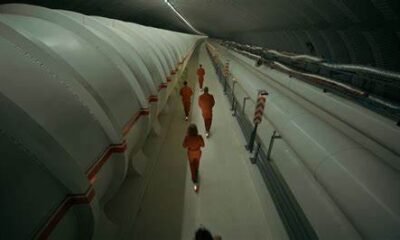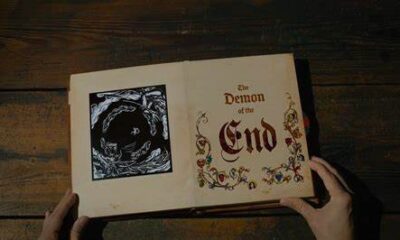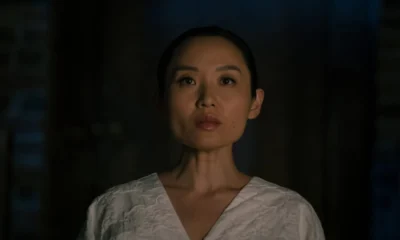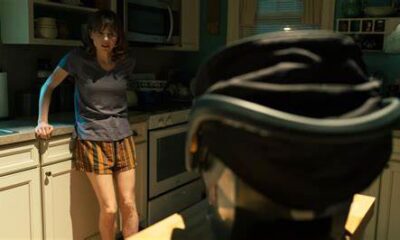
HMTL Recap and Review – Creepshow S1E5
Welcome to Haunted MTL’s ongoing coverage of Shudder’s original series, Creepshow. Tonight featured two segments, a genuinely great tale in the classic sort of horror anthology and weird tale mold. The other was a half-cooked, scattershot revenge story that really showcased the budget-crunch of Creepshow. It was a half-hour of undead highs and lows this week.
“Night of the Paw”

John Harrison, a Creepshow veteran, returns to direct this classical tale of wishes gone horribly, horribly wrong. This is, by far, the most stylized segment on the series thus far, and really took advantage of the comic book theming of the overall show. This is, sadly John Esposito’s first written episode of the series, but with any luck, he will be back more than once in season two. This episode is just that good.
The episode really has two principal actors; Bruce Davison and Hannah Barefoot spend most of the episode together, though other credits include Susannah Devereux and Ryan Clay Gwaltney. Graze Toso also deserves a nod for her work as zombie Marjorie. Bruce Davison is a veteran actor of film and television who is a real get for the episode who really sells the character of Avery.
The episode has a feeling of artifice that runs through it, though this is not a bad thing. The cemetery of Avery’s tale looks like a set, “action” scenes are instead tackled through comic book panels, and the color and lighting are tailored to emphasize the artificial nature of the episode. This feels very much like something from an E.C. Comic brought to life, as though panels were made three dimensional.
The story is nothing extraordinary, as it is the trope of the Monkey Paw after all. Why the segment works so well, however, is that the performances of Davison and Barefoot are magnetic in telling such a dire tale of wishes gone bad.
This could have easily been a segment in the first Creepshow film. It is that good.
Bottom Line
While nothing about “Night of the Paw” is really all that surprising or shocking (with the exception of the cutting off of two broken fingers, wow) it still works. The segment plays out exactly as you would expect, but that doesn’t matter because it’s just so satisfying to see it all play out.
 (4.5 / 5)
(4.5 / 5)
“Times is Tough in Musky Holler”

Unfortunately, the second segment of the night might be the weakest link in a generally strong season. It’s incredible considering that John Harrison directed this segment as well. The segment, written by John Skipp and Dori Miller just does not deliver outside of delivering some good gore. The episode stars Dane Rhodes, Karen Strassman, Tommy Kane, Tracey Bonner. David Arquette is also along for the ride.
When zombies rise in the world, possibly due to the final wish of Angela from “Night of the Paw,” the worst sort of people take it upon themselves to spread their will over the people around them. “Times is Tough in Musky Holler” ends up being a small revenge story at the end of a brutal regime that was instituted by a used car salesman in the post-apocalyptic world.
This zombie story is more Z-Nation than The Walking Dead, however. Nobody really comes off as particularly interesting and what little glimpses of the regime’s brutality render largely as just… there. The punishment used by society, fittingly the last time it will ever be used, is comical in its cruelness. But it is a payoff that never really feels greater than an excuse to try a new effects technique in which a zombie rips off a human face.
Granted, it is a very well done kill, and it is the highlight of that segment. The problem is, the segment feels more like it was written around the idea of “how do we have a zombie rip this someone’s face off? The episode features a whole host of representatives of the previous regime, but they get little to do. David Arquette is particularly wasted.
As a whole, the segment feels a bit more like an effects school student’s short film than an anthology tale.
Bottom Line
Either the team needed something very short to fill in the episode behind “Night of the Paw” or the temptation to rip off a person’s face was far too great. In either case, this might be the weakest segment on the show.
 (2 / 5)
(2 / 5)
The Creep Factor

There was surprisingly little of the Creep this week. The episode was bookended near entirely with animation and the wonderful Creep animatronic is nowhere in sight.
It pains me to say this as an animation fan, but the animated segments of Creepshow largely do not work. The animation itself is decent enough, but the illustrations feel very flat. This is likely due to the shading style. For the inevitable season two, I would prefer to see the show moving away from this style or at least give the illustrations a more comic-book appropriate coloring style.
Or better yet, just use that fancy-ass animatronic Creep!
We hope that you enjoyed our coverage of the fifth installment of Shudder’s Creepshow. Creepshow will air on Thursdays around 9 PM EST on Shudder. Haunted MTL will be covering the whole 6 episodes of the first season.
Movies n TV
Wheel of Time A Question of Crimson Is a Political Espionage Delight
Episode two of Wheel of Time felt like the beginning of a long journey. Stories are unfolding, lives are changing, and blood is spilling.
Let’s discuss.
The story
We begin this episode in the past with Elayne’s mother, Queen Morgase. It turns out her rise to the throne was a bit, shall we say, cutthroat. So when she shows up at the White Tower, Siuan is concerned.
She might have reason to be, too.
Meanwhile, Rand, Egwene, Moiraine, Lan and Aviendha are in the Spine of The World. As they travel through some of the most breathtaking lands I have ever seen on a TV show, Egwene is plagued with nightmares. We think at first that’s just her trauma working itself through her system. But we soon find out that it might not be that straightforward.
Finally, Perrin returns home to heal after his hand is almost cut in half. But when he gets there he finds the town has been infested by Children of The Light. And they’re looking for him.
What worked
There was something heartwarming in this episode about political espionage and choking religious persecution. And that is Elayne’s relationship with her family.
I have consumed a lot of fantasy content with royal families. And I have never once heard a princess call her mother ‘Mum’. I’ve never seen royal siblings get along. And I have sure as hell never seen a princess have a good relationship with her step-parent.
This was refreshing. Even though Queen Morgase is kind of a horrible person she seems like a good mother. And that’s an unexpected delight.

Of course, this is just one storyline among many. And while this can sometimes be overwhelming, in this case it wasn’t.
I’ll be honest, some of these storylines are going to drag for me. I know this because I’ve read some of the Wheel of Time books and I have an idea that not all the characters exactly pique my interest.
No one likes all the characters. No one likes all the storylines. While I am here for the political espionage between Queen Morgase and Siuan, not everyone likes it. While others might be fascinated with Selene trying to win Rand back, I couldn’t care less.
Having multiple storylines keeps everyone’s attention better. So long as things don’t get out of hand. Things can easily get out of hand. But this seems to be managed well.
So far.
What didn’t work
As I mentioned above, I’m not thrilled with Rand’s story at this point. And while it’s fine to not like a storyline when there are this many to choose from, it’s not fantastic that the one I like the least is the one involving our two main characters. And anytime we were with the team at the Spine of The World, the only thing that brought me joy was Moirain’s hat. It reminded me of Stockard Channing’s hat in Practical Magic.
The problem is that Rand is Charlie Brown with controversial magical powers. He is boring, serious, and pessimistic.
And yes, I understand that he has a heavy emotional burden and he’s the Dragon Reborn and that’s quite taxing and all. But let’s be fair, there isn’t a single person in this show that doesn’t have a heavy burden. And most of them manage to be fun occasionally.

All that being said, this episode of Wheel of Time did exactly what it needed to do. It set up conflicts at each of the three locations. It established emotional ties between the characters and the events. And it established goals for everyone.
This was, in short, a solid episode. Not groundbreaking, not mind-blowing or life changing. It was simply good. It was entertaining and moved the plot forward.
Well done.
 (3.5 / 5)
(3.5 / 5)
Movies n TV
Wheel of Time Returns With A Bang
Wheel of Time is back for season three. There are mixed feelings regarding this. Last season, there were some serious pacing issues. And some serious sticking to the book’s storyline issues. But we’re two seasons in, and we don’t give up so easily. So let’s dive into episode one, To Race the Shadow.
By the way, I highly recommend watching this episode with the subtitles on. You’ll see why.
The story
We begin this episode with Liandrin facing a trial of sorts for her rampant betrayal. She does her best to gaslight her Aes Sedai sisters into thinking that Siuan Sanche is the real traitor.

When that doesn’t work, she reveals how many Black Aes Sedai have actually infiltrated the tower.
Spoiler, it’s a lot.
In the aftermath, our whole team gathers to drink and enjoy one night of relaxation before they head out to the Tear to form an army for Rand. All is going well until they’re attacked by myriad creatures and a sentient axe.
What worked
This episode was long. It had a run time of an hour and eleven minutes. And a lot of that run time was spent in heavy dialog scenes.
Fortunately, these were well-done scenes.
If you’re going to have a lot of talking scenes, there are good ways and bad ways to do it. Last season, we saw lots of examples of the bad way to do it. But this episode did it well. For one thing, other things were going on while conversations were taking place. The characters are drinking, playing games, walking through an interesting city. And the scenes themselves didn’t stretch out. They weren’t repetitive. We heard what the character had to say, then we moved on.
It was also nice that the point of these scenes wasn’t just info dumps. We had character development. We had romantic interactions. We had plot development and foreshadowing.
Overall, this episode felt like what it was. A moment of calm before a storm.
Taking a step back, I’d be remiss if I didn’t address the fight scene at the start of the episode. Because it was epic.
The magic looked amazing. The martial arts that went along with it looked fantastic. The costumes were beautiful. It was just incredibly fun to watch.
More than that, it was emotional. We lost some characters in that fight that were important. And it was clearly emotionally shattering for many of our characters, who found themselves betrayed by people they trusted.
So many of them.
It was a great way to open the season.
What didn’t work
Despite that, this episode wasn’t without its flaws.
First off, there were a lot of dialog scenes. And they were good scenes, as I’ve already discussed. But it was one after another after another. And when your episode is, again, an hour and eleven minutes, it’s maybe a little much to have so much chit-chat. Couldn’t some of these conversations, important as they were, have been moved to maybe another episode?
Finally, I want to talk about Egwene’s travel through the arches.

I feel like maybe there were some deleted scenes here. Because there must have been more to that visit than what we saw, right?
We could have seen Egwene battle Rand. That would have been badass and emotionally devastating. We could have seen her with a quiet life with Rand back home at the Two Rivers. We could have seen anything except for the quick clip of Rand in a bloody river, followed by Egwene being shoved back out in a bloody shift.
No products found.
Bad job. But at least it wasn’t an extended scene of Moiraine collecting bathwater, and then taking a bath while looking sad. If we’d started this season with another scene like that, it might have broken my brain.
Amazon dropped the first three episodes at once. So we’ll be back soon to talk about episode two. See you then.
 (4 / 5)
(4 / 5)
Movies n TV
Entertaining as hell: Eight Legged Freaks (2002) Review
Early 2000s is a special era for the industry. It accepts the cheesiness and corniness of movie making, in turn producing some gems in their own right. Eight Legged Freaks starring David Arquette and young Scarlet Johanson is a horror comedy about giant spiders who overtake a small town. As crazy as that premise sounds, the movie surprisingly has a ton of heart and is super entertaining. Let’s review, shall we?
Plot
We start Eight Legged Freaks with a shot of toxic waste spilling into the water supply of Joshua, a spider farm owner. He is friends with Mike, one of our protagonists, who is a science geek and a spider enthusiast. Mike notices something quite right upon visiting Joshua, but no one takes him seriously. We are then introduced to the rest of the crew. Mike’s mother Samantha, the town sheriff, is too busy chasing Ashley, his sister, who is dating the town mayor’s son Bret (something Samantha does not approve of). We also have Chris, who returns to the town to save his father’s legacy in the town mines. He has opposition from Wade, Bret’s father, who wants to use the mines for his business ventures. Lots of drama going on that will only get juicier once the spiders get loose.
The creepy crawlies quickly dispose of Joshua and make their grand appearance after Ashley rejects Bret’s advances, abandoning him in the middle of a desert. A glorious chase sequence ensues as the spiders make their way towards the town, wreaking havoc on its residents. In a true horror fashion (which the movie acknowledges), it takes some convincing from Mike and then from Samantha for the town to take the threat seriously. The tongue-in-cheek style of narrative adds the comedy aspect to a movie that would otherwise burn out fairly quickly.
The remaining characters hide out in a shopping mall as it’s the only somewhat sturdy building in the area. This doesn’t last long as the spiders break in, forcing them to run through the mines. Their resources to fight the creepy crawlies off are limited as the methane gas doesn’t allow them to use firearms. Such conditions require resourceful thinking from Chris, who uses perfume to fend off the leader of the spider group and save himself during the climax of the movie.
Character dynamics are not forgotten once the action kicks in. We have Chris confessing his long-term feelings for Samantha which she knew all along, which provided some comedic relief. Bret also reunites with Ashley and apologises for being an asshole. Mike finally gets the appreciation he deserves as his knowledge saves the townsfolk more than once during the whole ordeal.
We end the movie with the town’s radio show person telling the story as an urban legend during his segment. This brings it into question – how much of it happened the way he said it did? We can only guess…
Overall thoughts
Eight Legged Freaks is a fun creature feature with some self-aware commentary on genre tropes that doesn’t take itself too seriously. The acting is good, the pacing fitting and the characters are likeable enough for you to want them to make it through. Definitely a must watch, if you don’t suffer from arachnophobia, that is.
 (5 / 5)
(5 / 5)
- What do you get when you cross toxic waste with a bunch of exotic spiders? Eaten! The townies of Prosperity, Arizona will all become a screaming smorgasbord if mutated arachnids as big as SUVs have their way in this comedy/horror crowd pleaser whose creators include the producers of Independence Day and Godzilla
- Spiders that leap like gazelles, web-spitting spiders, spiders that suck your insides out as if through a straw—they’re all among the behemoths conjured up by an inventive effects team
- David Arquette (Scream) leads the two-legged stars, mobilizing the citizenry in a last-ditch fight to survive
Last update on 2025-03-10 / Affiliate links / Images from Amazon Product Advertising API













